SystemMonitor (Virus Removal Instructions) - Simple Removal Guide
SystemMonitor Removal Guide
What is SystemMonitor?
SystemMonitor – is an adware-type program that bombards its users with all kinds of advertisements
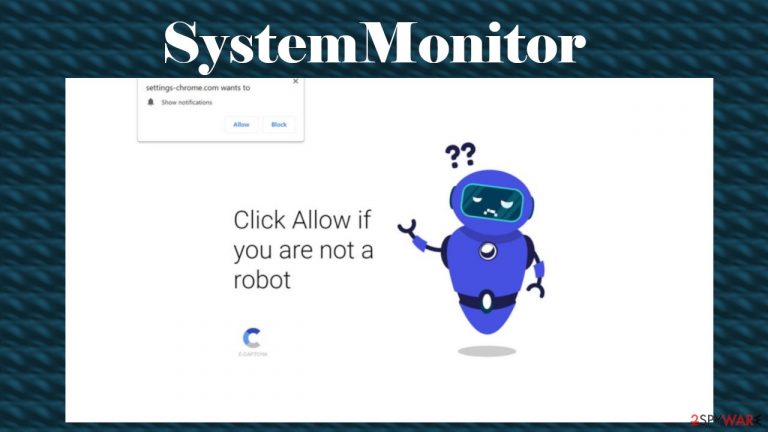
SystemMonitor is a potentially unwanted program because it shows deceptive ads, redirects users to hazardous affiliated websites, and collects browsing-related data. Furthermore, it exploits the legitimate “Managed by your organization” feature on Google Chrome browsers to make it harder to remove it. It's worth mentioning that this PUP can affect any device (Mac, Windows, Android) and any browser (Safari, Chrome, Firefox, etc.).
In most cases, SystemMonitor ads don't originate from websites that you're visiting. The displayed ads may include explicit, misleading, inappropriate content and can come in many forms – pop-ups, banners, in-text hyperlinks, or can even cover the whole browser window.
If any of these ads are clicked, you might be redirected to a malicious site, where more PUPs or even malware can be downloaded. If you have this adware installed on your device, you came to the right place to find out how to get rid of it once and for all and to find out more about these types of infections.
| name | SystemMonitor |
|---|---|
| Type | PUP, adware, redirect virus |
| symptoms | A slower internet connection and overall device performance, intrusive ads and redirects to dubious websites |
| Risks | Redirects might lead to shady portals where users will be pushed to install additional PUPs, give up their private details, etc. |
| Additional info | To establish persistence, this adware adds the “Managed by your organization” feature |
| Distribution | Deceptive ads, software bundles |
| detection names | Trojan.Win32.Ekstak.ainyd, Spyware.FickerStealer, Trojan:Win32/Ymacco.AA23, Trojan.Gen.MBT, RDN/Generic Downloader.x[1] |
| Removal | To completely eliminate this PUP from any device, users must use a trustworthy anti-malware tool |
| system fix | To restore corrupted system files and wipe tracking cookies, use the FortectIntego system optimizer |
As we've mentioned before, SystemMonitor redirects and ads may endanger users. Adware operators don't care where their money comes from, as long as it keeps coming. So users could get redirected to sites with explicit or even malicious content, where their devices could get infected with severe malware.
A technique called drive-by downloads[2] doesn't even require the user to click on anything in a redirected website. The virus payload file, if programmed to, could get downloaded automatically. Furthermore, SystemMonitor adware can record your browsing habits and details, such as:
- most visited sites,
- search queries,
- device and browser details,
- IP addresses,
- geolocation, etc.
This data is usually used to make ads just for you. But there's no guarantee that such details won't be shared with third-parties that could misuse this information for mischievous deeds. It is unsafe to use this adware. Thus we recommend users remove SystemMonitor from their devices immediately.
Reliable anti-malware software will be required for this task. If you don't own one, we recommend either SpyHunter 5Combo Cleaner or Malwarebytes. Either of these apps is capable of identifying, locating, isolating, and removing the adware with all of its particles. Launch the security tool, scan the whole system, and stick to the AV tool recommendations to proceed.
Manual SystemMonitor removal might be necessary to get rid of the irritating “Managed by your company” error. At the bottom of this article, we've provided detailed free instructions on removing this feature from Google Chrome browsers.
If you've clicked on any SystemMonitor ads or were redirected to questionable sites, you have to scan your device for system irregularities and tracking cookies. Experts[3] have agreed that the best all-around tool for that is the powerful FortectIntego system repair software.
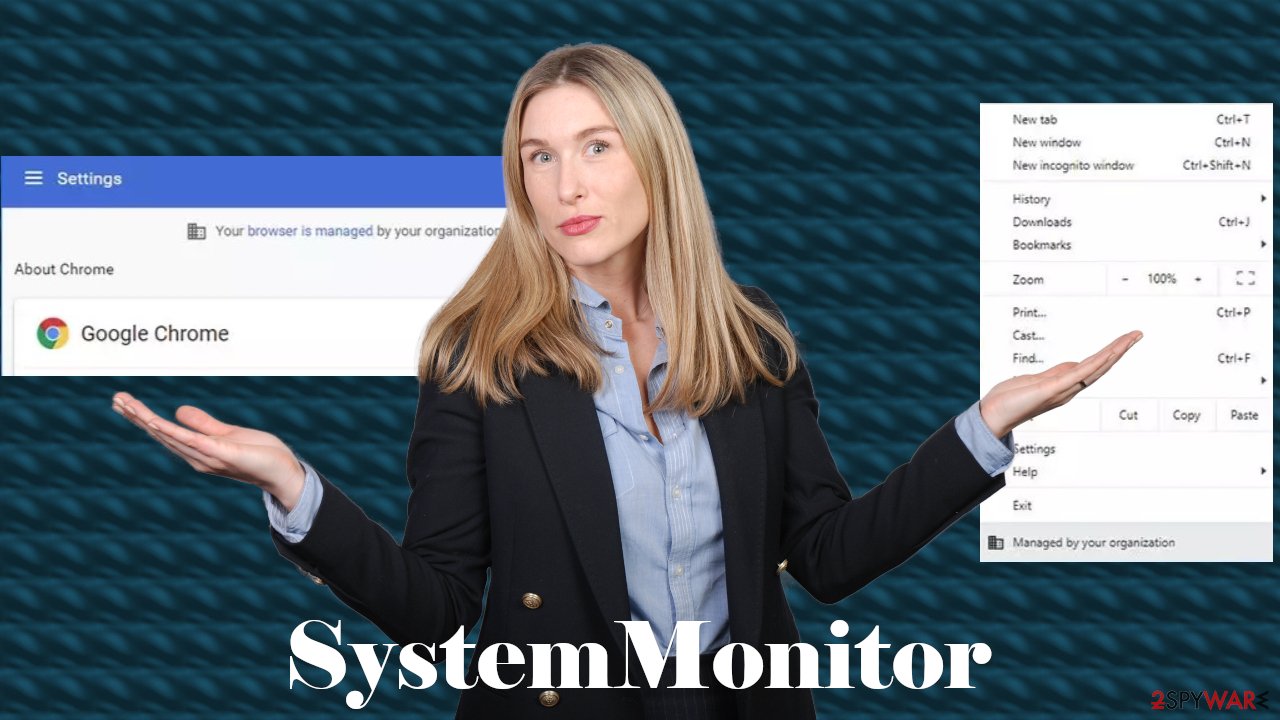
Avoid software from deceptive ads and bundles
Although adware, browser hijackers, and other potentially unwanted programs have been around for a while now, people still get tricked into installing them. There are two main ways that PUPs are installed – either through deceptive ads or with software/freeware bundles.
Misleading ads on shady websites can tell that you desperately need to update your outdated software or install an AV tool because a virus was detected. Internet users have to remember one thing – no website can determine if your software is out of date or whether you have a malware infection. Please don't believe what you see in ads and download only legitimate, verified software straight from its developers.
Another trick that PUP operators use is adding their creations to software or freeware bundles. Apps in these packs are pre-selected for installation, so as soon as Standard/Recommended/Quick installation is chosen, all apps, including PUPs, are installed. If there is no other way to obtain a program that you want apart from a bundle, select the Advanced/Custom mode and deselect all additional apps you don't want.
Remove SystemMonitor to evade other PUPs and malware
Potentially unwanted programs aren't as hazardous as malware,[4], but that doesn't mean that it's safe to keep using them. Like the SystemMonitor virus, adware severely impedes the browsing experience by bombarding its users with ads, redirects and may lead to other PUP installations.
Therefore, you should remove SystemMonitor from your device as soon as possible. The best way to do that is by entrusting this task to a professional anti-malware tool that will do it automatically. Furthermore, keep your AV tool virus database updated regularly so it could stop PUPs and malware from infecting your machine.
You might have to finish SystemMonitor removal manually. It might seem challenging, but we're here to help, so stick to our guidelines below, and you'll be done within a couple of minutes. Afterward, run system diagnostics with powerful system repair tools to delete tracking cookies and get your device back to normal.
You may remove virus damage with a help of FortectIntego. SpyHunter 5Combo Cleaner and Malwarebytes are recommended to detect potentially unwanted programs and viruses with all their files and registry entries that are related to them.
Getting rid of SystemMonitor. Follow these steps
Uninstall from Windows
Instructions for Windows 10/8 machines:
- Enter Control Panel into Windows search box and hit Enter or click on the search result.
- Under Programs, select Uninstall a program.

- From the list, find the entry of the suspicious program.
- Right-click on the application and select Uninstall.
- If User Account Control shows up, click Yes.
- Wait till uninstallation process is complete and click OK.

If you are Windows 7/XP user, proceed with the following instructions:
- Click on Windows Start > Control Panel located on the right pane (if you are Windows XP user, click on Add/Remove Programs).
- In Control Panel, select Programs > Uninstall a program.

- Pick the unwanted application by clicking on it once.
- At the top, click Uninstall/Change.
- In the confirmation prompt, pick Yes.
- Click OK once the removal process is finished.
Delete from macOS
Remove items from Applications folder:
- From the menu bar, select Go > Applications.
- In the Applications folder, look for all related entries.
- Click on the app and drag it to Trash (or right-click and pick Move to Trash)

To fully remove an unwanted app, you need to access Application Support, LaunchAgents, and LaunchDaemons folders and delete relevant files:
- Select Go > Go to Folder.
- Enter /Library/Application Support and click Go or press Enter.
- In the Application Support folder, look for any dubious entries and then delete them.
- Now enter /Library/LaunchAgents and /Library/LaunchDaemons folders the same way and terminate all the related .plist files.

Remove from Microsoft Edge
Delete unwanted extensions from MS Edge:
- Select Menu (three horizontal dots at the top-right of the browser window) and pick Extensions.
- From the list, pick the extension and click on the Gear icon.
- Click on Uninstall at the bottom.

Clear cookies and other browser data:
- Click on the Menu (three horizontal dots at the top-right of the browser window) and select Privacy & security.
- Under Clear browsing data, pick Choose what to clear.
- Select everything (apart from passwords, although you might want to include Media licenses as well, if applicable) and click on Clear.

Restore new tab and homepage settings:
- Click the menu icon and choose Settings.
- Then find On startup section.
- Click Disable if you found any suspicious domain.
Reset MS Edge if the above steps did not work:
- Press on Ctrl + Shift + Esc to open Task Manager.
- Click on More details arrow at the bottom of the window.
- Select Details tab.
- Now scroll down and locate every entry with Microsoft Edge name in it. Right-click on each of them and select End Task to stop MS Edge from running.

If this solution failed to help you, you need to use an advanced Edge reset method. Note that you need to backup your data before proceeding.
- Find the following folder on your computer: C:\\Users\\%username%\\AppData\\Local\\Packages\\Microsoft.MicrosoftEdge_8wekyb3d8bbwe.
- Press Ctrl + A on your keyboard to select all folders.
- Right-click on them and pick Delete

- Now right-click on the Start button and pick Windows PowerShell (Admin).
- When the new window opens, copy and paste the following command, and then press Enter:
Get-AppXPackage -AllUsers -Name Microsoft.MicrosoftEdge | Foreach {Add-AppxPackage -DisableDevelopmentMode -Register “$($_.InstallLocation)\\AppXManifest.xml” -Verbose

Instructions for Chromium-based Edge
Delete extensions from MS Edge (Chromium):
- Open Edge and click select Settings > Extensions.
- Delete unwanted extensions by clicking Remove.

Clear cache and site data:
- Click on Menu and go to Settings.
- Select Privacy, search and services.
- Under Clear browsing data, pick Choose what to clear.
- Under Time range, pick All time.
- Select Clear now.

Reset Chromium-based MS Edge:
- Click on Menu and select Settings.
- On the left side, pick Reset settings.
- Select Restore settings to their default values.
- Confirm with Reset.

Remove from Mozilla Firefox (FF)
Remove dangerous extensions:
- Open Mozilla Firefox browser and click on the Menu (three horizontal lines at the top-right of the window).
- Select Add-ons.
- In here, select unwanted plugin and click Remove.

Reset the homepage:
- Click three horizontal lines at the top right corner to open the menu.
- Choose Options.
- Under Home options, enter your preferred site that will open every time you newly open the Mozilla Firefox.
Clear cookies and site data:
- Click Menu and pick Settings.
- Go to Privacy & Security section.
- Scroll down to locate Cookies and Site Data.
- Click on Clear Data…
- Select Cookies and Site Data, as well as Cached Web Content and press Clear.

Reset Mozilla Firefox
If clearing the browser as explained above did not help, reset Mozilla Firefox:
- Open Mozilla Firefox browser and click the Menu.
- Go to Help and then choose Troubleshooting Information.

- Under Give Firefox a tune up section, click on Refresh Firefox…
- Once the pop-up shows up, confirm the action by pressing on Refresh Firefox.

Remove from Google Chrome
Delete malicious extensions from Google Chrome:
- Open Google Chrome, click on the Menu (three vertical dots at the top-right corner) and select More tools > Extensions.
- In the newly opened window, you will see all the installed extensions. Uninstall all the suspicious plugins that might be related to the unwanted program by clicking Remove.

Clear cache and web data from Chrome:
- Click on Menu and pick Settings.
- Under Privacy and security, select Clear browsing data.
- Select Browsing history, Cookies and other site data, as well as Cached images and files.
- Click Clear data.

Change your homepage:
- Click menu and choose Settings.
- Look for a suspicious site in the On startup section.
- Click on Open a specific or set of pages and click on three dots to find the Remove option.
Reset Google Chrome:
If the previous methods did not help you, reset Google Chrome to eliminate all the unwanted components:
- Click on Menu and select Settings.
- In the Settings, scroll down and click Advanced.
- Scroll down and locate Reset and clean up section.
- Now click Restore settings to their original defaults.
- Confirm with Reset settings.

Delete from Safari
Remove unwanted extensions from Safari:
- Click Safari > Preferences…
- In the new window, pick Extensions.
- Select the unwanted extension and select Uninstall.

Clear cookies and other website data from Safari:
- Click Safari > Clear History…
- From the drop-down menu under Clear, pick all history.
- Confirm with Clear History.

Reset Safari if the above-mentioned steps did not help you:
- Click Safari > Preferences…
- Go to Advanced tab.
- Tick the Show Develop menu in menu bar.
- From the menu bar, click Develop, and then select Empty Caches.

Uninstall from Android
Uninstall unwanted programs from Android device:
- Go to Settings -> Apps/Applications.
- Expand the full list of the installed apps.
- Scroll through the list and tap on a suspicious application once.
- Tap on it and select Uninstall.
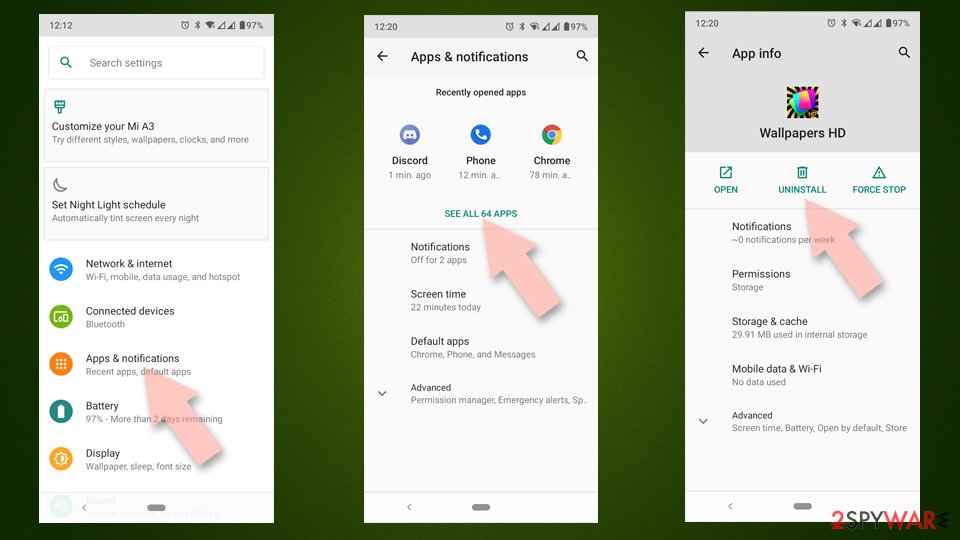
- Reboot the device.
Clear Storage and data files on Android from Google Chrome or other apps:
- Go to Settings > Apps/Applications.
- Expand the full list of the installed apps.
- Tap on Chrome and select Storage & cache.
- Clear storage and clear cache of the app.
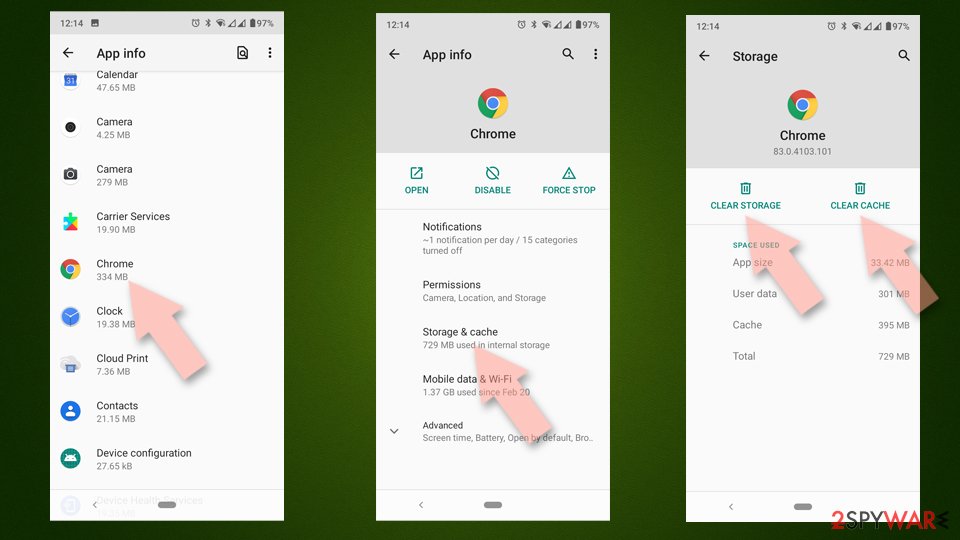
If you are seeing ads on top of other apps but are not sure what is causing it, perform the following steps:
- Go to Apps/Applications.
- Tap Advanced.
- Select Special App access.
- Tap on Display over other apps.
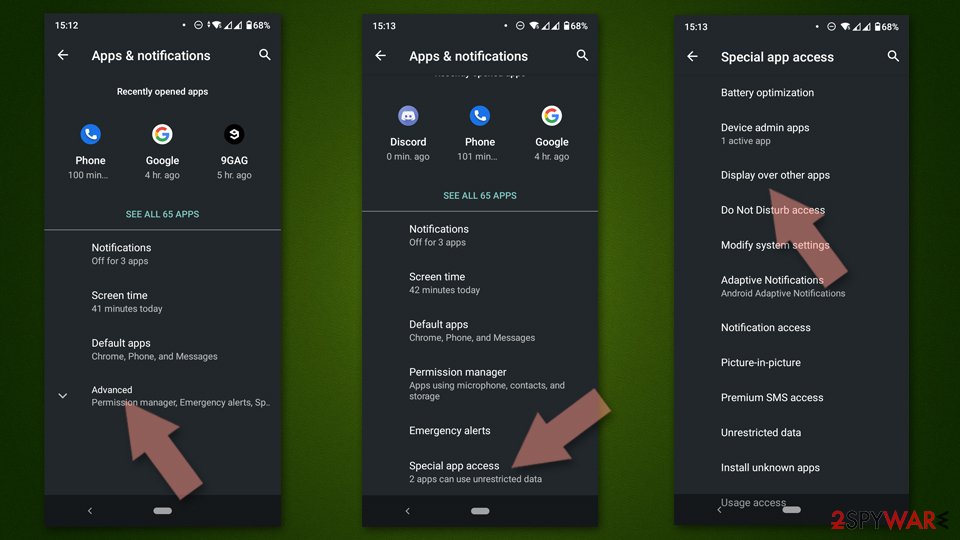
- Eliminate apps with these access rights enabled.
Stop browser notifications
Remove unwanted notifications from Google Chrome (desktop):
- Open Google Chrome browser and go to Menu > Settings.
- Scroll down and click on Advanced.
- Locate Privacy and security section and pick Site Settings > Notifications.

- Look at the Allow section and look for a suspicious URL.
- Click the three vertical dots next to it and pick Block. This should remove unwanted notifications from Google Chrome.

Remove unwanted notifications from Google Chrome (Android):
- Open Google Chrome and tap on Settings (three vertical dots).
- Select Notifications.
- Scroll down to the Sites section.
- Locate the unwanted URL and toggle the button to the left (Off setting).

Remove unwanted notifications from Mozilla Firefox:
- Open Mozilla Firefox and go to Menu > Options.
- Click on Privacy & Security section.
- Under Permissions, you should be able to see Notifications. Click the Settings button next to it.

- In the Settings – Notification Permissions window, click on the drop-down menu by the URL in question.
- Select Block and then click on Save Changes. This should remove unwanted notifications from Mozilla Firefox.

Remove unwanted notifications from Safari:
- Click on Safari > Preferences…
- Go to the Websites tab and, under General, select Notifications.
- Select the web address in question, click the drop-down menu and select Deny.

Remove unwanted notifications from MS Edge:
- Open Microsoft Edge, and click the Settings and more button (three horizontal dots) at the top-right of the window.
- Select Settings and then go to Advanced.
- Under Website permissions, pick Manage permissions and select the URL in question.

- Toggle the switch to the left to turn notifications off on Microsoft Edge.

Remove unwanted notifications from MS Edge (Chromium):
- Open Microsoft Edge, and go to Settings.
- Select Site permissions.
- Go to Notifications on the right.
- Under Allow, you will find the unwanted entry.
- Click on More actions and select Block.

Remove unwanted notifications from Internet Explorer:
- Open Internet Explorer, and click on the Gear icon at the top-right of the window.
- Select Internet options and go to the Privacy tab.
- In the Pop-up Blocker section, click on Settings.
- Locate web address in question under Allowed sites and pick Remove.

After uninstalling this potentially unwanted program (PUP) and fixing each of your web browsers, we recommend you to scan your PC system with a reputable anti-spyware. This will help you to get rid of SystemMonitor registry traces and will also identify related parasites or possible malware infections on your computer. For that you can use our top-rated malware remover: FortectIntego, SpyHunter 5Combo Cleaner or Malwarebytes.
How to prevent from getting adware
Do not let government spy on you
The government has many issues in regards to tracking users' data and spying on citizens, so you should take this into consideration and learn more about shady information gathering practices. Avoid any unwanted government tracking or spying by going totally anonymous on the internet.
You can choose a different location when you go online and access any material you want without particular content restrictions. You can easily enjoy internet connection without any risks of being hacked by using Private Internet Access VPN.
Control the information that can be accessed by government any other unwanted party and surf online without being spied on. Even if you are not involved in illegal activities or trust your selection of services, platforms, be suspicious for your own security and take precautionary measures by using the VPN service.
Backup files for the later use, in case of the malware attack
Computer users can suffer from data losses due to cyber infections or their own faulty doings. Ransomware can encrypt and hold files hostage, while unforeseen power cuts might cause a loss of important documents. If you have proper up-to-date backups, you can easily recover after such an incident and get back to work. It is also equally important to update backups on a regular basis so that the newest information remains intact – you can set this process to be performed automatically.
When you have the previous version of every important document or project you can avoid frustration and breakdowns. It comes in handy when malware strikes out of nowhere. Use Data Recovery Pro for the data restoration process.
- ^ VirusTotal. Virustotal. Suspicious file analysis platform.
- ^ Drive-by download. Wikipedia. The free encyclopedia.
- ^ Udenvirus. Udenvirus. Spyware news and security.
- ^ Roger A. Grimes. 9 types of malware and how to recognize them. Cso. Security news, features and analysis.
